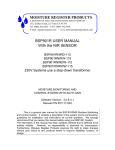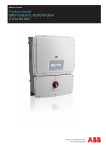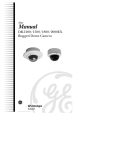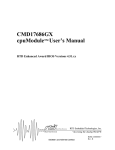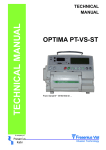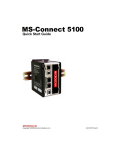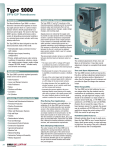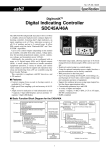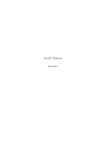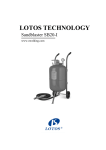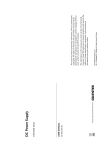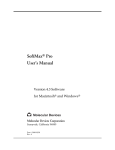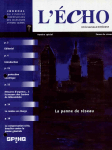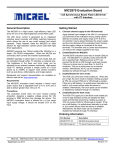Download 3920 Electronic RTD Temperature Transmitter & Series
Transcript
BARTON® 3920 Electronic RTD Temperature Transmitter & Series 20 RTD User Manual Manual No. 55165001, Rev. 01 SAFETY/CUSTOMER SERVICE NOTICE The warranty applicable to this product is stated at the beginning of this manual. Should any problem arise after-delivery, please contact the Cameron’s Measurement Systems HelpDesk at 1877-805-7226 or the Customer Service department during normal business hours at (403) 291-4814. Before installing the instrument, become familiar with the installation instructions. Also, be aware of the following important notice that appears in the manual: • WARNING notes indicate the presence of a hazard that can cause severe personal injury, death or substantial property damage if the warning is ignored. • CAUTION notes indicate the presence of a hazard, which will or can cause minor personal injury or property damage if the warning is ignored. © 2007 Cameron International Corporation (“Cameron”). All information contained in this publication is confidential and proprietary property of Cameron. Any reproduction or use of these instructions, drawings, or photographs without the express written permission of an officer of Cameron is forbidden. All Rights Reserved. Printed in the United States of America. Manual No. 55165001, Rev. 01 March 2007 Table of Contents TABLE OF CONTENTS INTRODUCTION........................................................................................................................................... 1 General...................................................................................................................................................... 1 Product Description ................................................................................................................................... 1 Model Identification.................................................................................................................................... 1 CHAPTER 1: INSTALLATION ..................................................................................................................... 3 Unpacking.................................................................................................................................................. 3 Mounting.................................................................................................................................................... 3 Electrical Installation.................................................................................................................................. 3 Intrinsically Safe Installation ...................................................................................................................... 4 Explosionproof Installation ........................................................................................................................ 4 CHAPTER 2: CALIBRATION....................................................................................................................... 7 Introduction................................................................................................................................................ 7 Controls Description and Location ............................................................................................................ 7 Required Equipment and Tools................................................................................................................. 7 Calibration Setup ....................................................................................................................................... 8 Calibration Procedure................................................................................................................................ 9 Gross Range Changes .............................................................................................................................. 9 CHAPTER 3: OPERATION ........................................................................................................................ 11 General Theory of Operation................................................................................................................... 11 CHAPTER 4: MAINTENANCE................................................................................................................... 13 Removal of EM-Module from Explosionproof Enclosures....................................................................... 13 Installation of EM Module in Explosionproof Housings ........................................................................... 13 Connector Cleaning................................................................................................................................. 13 CHAPTER 5: SPECIFICATIONS ............................................................................................................... 15 General.................................................................................................................................................... 15 Options .................................................................................................................................................... 18 Order Code (Model 3920) ....................................................................................................................... 19 3920 Housing Configurations.............................................................................................................. 21 Order Code (Series 20) ........................................................................................................................... 22 Outline Dimension Drawings ................................................................................................................... 23 3920 Integral Blind Transmitter & Series 20 RTD with Terminal Housing ....................................... 23 3920 Integral Indicating Transmitter (and Blind Transmitters or Series 20 with “GB” Option) ........ 24 3920 Pipe Mount Transmitter (Indicating or Blind)............................................................................ 25 3920 Remote Indicating Transmitter (and Blind Transmitters with “GB” Option) ............................ 26 CHAPTER 6: PARTS LIST......................................................................................................................... 27 3920 Housing Assembly.......................................................................................................................... 27 3920 Module Assembly ........................................................................................................................... 29 March 2007 i Barton 3920 Electronic RTD Temperature Transmitter & Series 20 RTD ii March 2007 Introduction General This manual contains installation, operational and technical information for two separate products, the Barton® 3920 RTD Temperature Transmitter and the Series 20 RTD Sensor. Read all sections of this manual before installing or operating these units. Product Description The Model 3920 uses a 2 or 3-wire resistive temperature detector to provide a proportional 4-20 mA analog current output. The 3920 boards are enclosed in an oval extruded aluminum protective housing. The Barton Model 3920 is available in four configurations for application flexibility: EM Version “Electronics module” consisting of a circuit assembly (two printed circuit boards) enclosed in a protective cast aluminum housing with external controls for span and zero adjustments. WL Version “Wall-mount” version of the EM module; two metal flanges for wall or surface mounting. Hazardous Location Two-piece cast aluminum alloy explosionproof enclosure (available in indicating and blind versions). The EM module is held in place within the enclosure by a spring clip. RF Unit Option Additional protection for Radio Frequency (RF) interference is offered as an option on the EM or WL modules. This is not normally offered on a hazardous location model since the aluminum shell of the Hazardous Location enclosure offers inherent RF shielding. On the EM module, the standard input connector is replaced by an alternate input connector that contains a printed circuit board and the filter. Dimensionally, a RF equipped module is approximately 10 mm (3/8”) taller. The Series 20 is a 3-wire RTD normally supplied with an integral hazardous location housing. It is a subset of the 3920 and may be supplied with or without a 3920. When it is supplied with the 3920, it serves as a remote sensor to the electronics module. When the Series 20 is supplied by itself, it is used to provide a RTD sensor resistance to some other electronic system. The Series 20 is physically identical to the blind 3920 except that the electronics module is replaced by a simple terminal strip. Model Identification Each instrument has a label mounted on the back of the housing with the model number and serial number that identifies its type, functional characteristics, parameters, and the options ordered. On 3920 Hazardous Location models, there is a second label on the back of the electronics module. March 2007 1 Barton 3920 Electronic RTD Temperature Transmitter & Series 20 RTD 2 March 2007 Chapter 1: Installation Unpacking The Barton Model 3920 Electronic RTD Temperature Transmitter was inspected and tested during manufacture and prior to shipment. However, an inspection should be performed at the time of unpacking to detect any damage that may have occurred during shipment. The following items are included in each shipment: • Model 3920 Electronic RTD Temperature Transmitter and/or Series 20 RTD Sensor, with all options as specified • Installation and Operation Manual Mounting Consideration should be given to ensure that the temperature of the electronics module does not exceed 85°C (180°F). Although the modules do not generate measurable amounts of heat on their own, hazardous location housings can trap heat that is absorbed through conduction or radiation from the process. Where excessively high temperatures are expected, the Series 20 RTD, with an appropriate temperature-rated terminal block, should be selected. When mounting, also consider the ease of access for calibration, maintenance purposes and the regular viewing of the optional display. In situations where this would be a problem, the Series 20 Remote RTD may provide a solution since it has no parts that require access. When the Series 20 is used, it should be mounted so that the cable length is as short as possible. It is not recommended that the interconnecting cable length exceed 150 m (500 ft.). Electrical Installation All electrical connections are made to the integral terminal strip on the unit. To avoid transients and stray electrical noises, it is recommended that twisted conductors with an overall shield be used. The distance that a 3920 can transmit its signal is a function of the cable resistance and the power supply voltage. Units are designed to operate directly from a DC power source. Connect power leads to +PS and – PS terminals. Observe the proper polarity. It is not recommended that the cable length linking the Series 20 RTD to the receiving electronics exceed 150 m (500 ft.). The interconnecting cable should be a twisted “triad” constructed of minimum 18 AWG copper wire. The three conductors should have an overall shield. March 2007 3 Barton 3920 Electronic RTD Temperature Transmitter & Series 20 RTD Intrinsically Safe Installation When installed as per drawing 3920-9000-0 (page 4) and local electrical code requirements, the 3920 is CSA listed as Intrinsically Safe. The Series 20, being CSA approved and a simple device, may be installed as Intrinsically Safe by protecting the RTD with any appropriate CSA approved I.S. barrier. At an additional cost, Cameron will supply an appropriate I.S. barrier. An I.S. barrier is not required between a 3920 and a Series 20 remote RTD when the 3920 is protected by a barrier. Explosionproof Installation When equipped with Hazardous Location housing, the cover is in place and installation is carried out as per local code requirements. The entire assembly is CSA approved. WARNING SPRING-LOADED RTD PROBES AS USED ON SERIES 20 RTDs AND 3920 TEMPERATURE TRANSMITTERS ARE EXPLOSIONPROOF ONLY WHEN INSTALLED IN A CAMERON-SUPPLIED THERMOWELL. DE-ENERGIZE CIRCUITS OR OTHERWISE RENDER THE AREA SAFE BEFORE REMOVING THE RTD FROM THE THERMOWELL. 4 March 2007 Chapter 1: Installation March 2007 5 Barton 3920 Electronic RTD Temperature Transmitter & Series 20 RTD 6 March 2007 Chapter 2: Calibration Introduction All Model 3920 transmitters are accurately adjusted at the factory before shipment. Unless otherwise specified, the factory calibration is performed using a decade resistance box in place of the RTD. Series 20 models and other RTDs are not factory checked for conformance, as no adjustments are possible. CAUTION DO NOT CHECK OR ADJUST ANY UNIT UNLESS PROPER TOOLS AND TEST SETUP WITH CURRENT PROCEDURES ARE AVAILABLE AND UNDERSTOOD. Controls Description and Location The external controls consist of zero and span adjustments located on the EM’s top cover. Each control is a multiturn potentiometer that is adjusted with a blade screwdriver. CAUTION USE A BLADE SCREWDRIVER THAT IS NO MORE THAN 0.1 IN (2.54mm) WIDE. A WIDER BLADE MAY PERMANENTLY DAMAGE THE POTENTIOMETER MOUNTING. A SCREWDRIVER WITH A PLASTIC SHANK MUST BE USED TO ADJUST A RF-OPTION UNIT; A METAL SHANK TOOL CAN CIRCUMVENT THE RF IMMUNITY AND COMPROMISE ADJUSTMENTS. The zero and span pots usually require 22 turns of the shaft to move the wiper from one end of its range to the other. The pot is equipped with a slip clutch at either end of its travel to prevent damage if it is turned beyond the wiper stop. Slightly more torque is required to turn the shaft when the clutch is slipping. If this torque cannot be observed, either end of the pot can be reached by 22 turns of the shaft in the direction desired: • CLOCKWISE on the control to INCREASE the quantity (make it more positive) • COUNTERCLOCKWISE to DECREASE the quantity (make it more negative) Required Equipment and Tools All equipment listed below must be procured by the user before calibration: Equipment/Tool Screwdriver Blade RTD or Resistance Decade Box DC Voltmeter or Multimeter March 2007 Characteristic Blade not wider than 0.1” (2.54mm) Accuracy ±0.05% or better Accuracy ±0.05% or better Purpose Adjust zero or span Simulate RTD input Monitor output signal 7 Barton 3920 Electronic RTD Temperature Transmitter & Series 20 RTD Calibration Setup The general setup necessary to calibrate all configuration of the Model 3920 is shown below. This also depicts the general setup for various sensor configurations. Note: The protective housing must be opened to expose the connection block in the hazardous location configuration. EITHER AMPMETER OR VOLTMETER RESISTANCE BOX A B C + +PS 3920 -PS - 12 TO 42V + I - V POWER SUPPLY + a. Standard Unit RESISTANCE BOX AH BH 3920 RESISTANCE BOX AL BL + +PS -PS - 12 TO 42V I + - V POWER SUPPLY + b. Units With DT Option 8 March 2007 Chapter 2: Calibration Calibration Procedure 1. Connect the unit and test equipment as shown in the previous section. 2. Apply power to the unit. Note: Use the model identification number to obtain specified input and output minimums and maximums. 3. Adjust the resistance box to a value corresponding to the minimum temperature the RTD will measure in actual operation (see model identification number). 4. Adjust the zero potentiometer to obtain 0% output (4 mA) with the minimum resistance connected to the sensor terminals. 5. Adjust the resistance box to a value corresponding to the maximum temperature the RTD will measure in actual operation (see model identification number). 6. Adjust the span potentiometer to obtain 100% output with the maximum resistance applied as in Step 5. 7. Repeat Steps 3 through 6 until no further adjustment of zero or span potentiometer is required. 8. Subtract the minimum temperature in Step 3 from the maximum temperature used in Step 5. Calculate 25%, 50% and 75% of this difference. Convert these temperatures to their equivalent RTD resistances. Add these calculated percentages of resistance range to input used in Step 3. Adjust the resistance box to each of these values. Check that the output is linearly proportional (within ±0.1% of the output span). 9. After Step 8 is successfully completed, turn the power to the unit OFF. Disconnect test equipment. 10. Reinstall sensor and power wiring. 11. For hazardous location units, replace cover and reapply power. Gross Range Changes Occasionally, it may be desired to make a large change to the range of the 3920. This may involve a change to the zero, span or both. Typically, this occurs when the wrong range has been ordered for the application. While it is possible to make these changes in the field, it is recommended that the module be returned to Cameron’s Measurement Systems Division for adjustment or a replacement module is ordered. To perform a gross range change in the field, resistors will have to be replaced on the circuit board, which will require the use of a soldering iron. Additionally, the circuit boards receive a conformal coating in the factory. Therefore, after any modification, this coating will have to be repaired if long-term integrity is to be preserved. If this type of change is contemplated, please consult Cameron’s Measurement Systems Division for the necessary parts and a component layout drawing. The existing model number, current calibrated range and proposed calibrated range are needed to determine the parts required. March 2007 9 Barton 3920 Electronic RTD Temperature Transmitter & Series 20 RTD 10 March 2007 Chapter 3: Operation General Theory of Operation CONSTANT CURRENT GENERATORS (3 Places) +PS ZERO ADJ. A OUTPUT CURRENT DRIVER DIFFERENTIAL AMPLIFIER – + RTD B C SPAN ADJ. -PS The Model 3920 converts resistive input from an RTD into corresponding analog current output. The input signal at +PS / -PS is processed by a constant current circuit that develops a constant load across the power supply during a steady state condition. When the RTD increases in resistance, current drain from the power supply increases accordingly. The 3920 consists of constant current circuits, an input amplifier and output circuits. March 2007 11 Barton 3920 Electronic RTD Temperature Transmitter & Series 20 RTD 12 March 2007 Chapter 4: Maintenance The electronics module of the Model 3920 is comprised of group selected components; therefore, maintenance of the unit is limited to preventative measures. It is recommended that any unit performing below specifications be returned to the factory for service. If the urgency of repair does not allow time to send the unit back to the factory, it is recommended that the user purchases a spare unit. Removal of EM-Module from Explosionproof Enclosures When replacement of the electronics module is required, use the following procedure: WARNING SEVERE PROPERTY DAMAGE OR INJURY CAN RESULT IF THIS WARNING IS IGNORED. TURN OFF POWER AND INPUT SIGNAL TO THE INSTRUMENT BEFORE DISASSEMBLY OF UNIT. 1. Remove the condulet cover. 2. Disconnect all wires from their terminals. Note: Always identify wires before disconnecting them from their terminals. 3. Squeeze the two spring clips inward, and lift the entire electronics module out of the condulet. Installation of EM Module in Explosionproof Housings When installing the EM module into the explosionproof condulet enclosure, ensure that one of the flat sides of the module is facing the hubs for the external wiring. 1. Install the electronics module into the condulet. 2. Connect all wires to their respective terminals. 3. Install the condulet cover. Connector Cleaning A printed circuit board holds all electrical components. A small additional board provides contacts for the plug-in screw-clamp terminal block. Occasionally, modules that have been in service for an extended period may develop a resistive coating on the gold-plated contacts within the electronics module that link the plug-in boards. This coating may cause malfunction by decreasing the noise margin of the circuit. This contamination is usually the result of careless handling and is composed of fingerprints, salts and oils deposited when the plug-in boards are handled by the gold-plated contacts. Contamination by these organic substances can be greatly reduced by careful handling. Although the board connectors are the self-cleaning type, it may become necessary to clean the connectors to restore reliable operation. Organic materials may be removed by the use of a commercial electronics contact cleaner. Let the contacts air dry or wipe with a very fine non-abrasive material. March 2007 13 Barton 3920 Electronic RTD Temperature Transmitter & Series 20 RTD 14 March 2007 Chapter 5: Specifications General Input RTD platinum, 2 or 3-wire 1 mA maximum sensor current Resistivity 0.00385 ohm/ohm/°C 100 Ω at 0°C (0.00214 ohm/ohm/°F 100 Ω at 32°F) Temperature Range -300°F to +1000°F (-200°C to +540°C) Any temperature range may be specified within the resistance limits. Available spans are as follows (delta ohms) 5-10 (Special applications only. Reduced accuracy, typical ±0.25%) 10-20 20-40 40-80 80-160 160-320 320-640 Temperature Range Calculation 1. Determine minimum temperature to be measured: TMin:______________Deg. C Determine maximum temperature to be measured: TMax:______________Deg. C 2. From Resistance versus Temperature Table (next page), convert temperatures to their equivalent resistances. ______________Deg. C TMin = _______________R Min = Elevated Zero ______________Deg. C TMax =_______________R Max 3. (R) Range = (R) Max – (R) Min = _____________________OHMS 4. Choose input range: Spans (OHMS) 10 – 20 320 – 640 March 2007 15 Barton 3920 Electronic RTD Temperature Transmitter & Series 20 RTD Example: Requirements TMin = 0 Deg. C; TMax = 100 Deg. C From Lookup Tables RMin = 100.00 and RMax = 138.50 (OHMS) Range = RMax – RMin = 138.50 – 100.00 = 38.50 OHMS RMin = 100.00 Range = 38.50 Hence, Span is 20 – 40 OHMS (see No. 4 above) RESISTANCE VERSUS TEMPERATURE TABLE Values in Degrees Celsius TEMP 0 -10 -20 -30 -40 -50 -60 -70 -80 -90 Ω/°C -200 18.386 – – – – – – – – – – -100 60.230 56.166 52.082 47.975 43.842 39.681 35.488 31.264 27.010 22.720 0.4177 0 100.000 96.083 92.154 88.213 84.259 80.291 76.309 72.313 68.302 64.275 0.3975 0 10 20 30 40 50 60 70 80 90 Ω/°C °C TEMP °C 0 100.000 103.904 107.795 111.675 115.543 119.399 123.243 127.075 130.895 134.703 0.3850 100 138.500 142.285 146.058 149.820 153.570 157.308 161.035 164.750 168.454 172.146 0.3733 200 175.827 179.496 183.154 186.800 190.436 194.058 197.669 201.270 204.859 208.436 0.3617 300 212.002 215.556 219.099 222.631 226.151 229.659 233.156 236.642 240.116 243.578 0.3502 400 247.029 250.469 253.896 257.313 260.717 264.110 267.491 270.861 274.219 277.565 0.3387 500 280.899 284.222 287.533 290.832 294.119 297.394 300.657 303.908 307.148 310.375 0.3269 600 313.590 316.793 319.984 323.163 326.330 329.484 – – – – 0.3148 Ω/°C = Value at center of 100°C span Note: Temperature spans less than 100°F (55°C) require use of 1000Ω RTD. Power Input 12 Vdc (minimum) to 42 Vdc (maximum), measured at input terminals (limit imposed by CSA) Overvoltage: 60 Vdc (maximum) without damage Loop Load Effect: ±0.002% of span/volt change, measured at input terminals Adjustments Twenty-two turn potentiometers Span Adjustable across 2:1 ratio of full scale span Zero Nominal ±10% of selected span centered around the factory ordered zero Note: Span is field adjustable over a 2:1 turndown ratio. Zero is determined at the factory based on minimum temperature specified by customer. 16 March 2007 Chapter 5: Specifications Performance Accuracy ±0.1% of span (linearity and hysteresis) Ambient Temperature -40°F to +180°F (-40°C to +82°C) Temperature Effect ±0.01% of span/°F (±0.02%of span/°C) Output 4-20 mA (limited to 30 mA maximum) Load Capability 2400 2200 LIMIT 60VDC MAX. WITHOUT DAMAGE 2000 Load Capability (Ohms) 1800 1600 1500 ohms with 42VDC supply R(LOAD)= E-12 I 1400 pu ut 1200 20 4- 1000 m A O t 42VDC maximum (based on CSA listing) measured at the input terminals 800 600 600 ohms with 24VDC supply 400 200 0 10 12VDC minimum 20 30 40 Power Supply (Volts DC) 50 60 Weight Item Electronic Module Blind Condulet Indicating Condulet March 2007 Net Weight, lb (kg) 0.28 (0.13) 1.75 (0.79) 4 (1.81) Shipping, lb (kg) 1 (0.45) 3 (1.4) 5 (2.3) 17 Barton 3920 Electronic RTD Temperature Transmitter & Series 20 RTD Options Analog Indicator Scale 0-100% of output current standard; others available Size 1 5/8” diameter Accuracy 1.5% F.S. Hazardous Location Standard Class I, Division 1, Groups C and D; Class I, Division 2, Groups E, F and G; Class III; Enclosure 4 II and GB options Class I, Division 1, Groups B, C and D; Class I, Division 2, Groups E, F and G; Class III; Enclosure 4 RFI Immunity Module RFI 1 to 455 MHz at 50 V/m Error in Output Less than ±0.1% of span Note: For process media above +250°F (+120°C), the condulet housing with temperature electronics should be separated from the temperature sensor and installed at a distance which ensures ambient temperature for electronics between –40°F (-40°C) and +180°F (+82°C). For remote mounted units, specify 3-wire option. 18 March 2007 Chapter 5: Specifications Order Code (Model 3920) MODEL 3920 to Min. 1 DEG C Max. F1 STANDARD UNIT INCLUDES: 2W, 4-20 mA, output linear with temperature, 100 ohm RTD, blind hazardous location housing. 2 INPUT TYPE 2-wire 3-wire 3 TRANSMITTER OUTPUT 4-20 milliamperes 4 2W 3W 20 OUTPUT TYPES Linear with temperature Differential temperature Reverse Output Linear with resistance 5 LN DT RO UC HOUSINGS None, Electronic Module Only, Aluminum (No probe supplied) 2 None, Electronic Module Only, Wall Mountable (No probe supplied)2 Integral, Hazardous Location, blind 3 (4 with GB) Integral, Hazardous Location, 0-100% Indicating 4 Remote, Hazardous Location, Blind3 Remote, Hazardous Location, Blind Wall Mountable3 (4 with NP) Remote, Hazardous Location, 0-100% Indicating, Wall Mountable3 (4 with NP) Remote, Hazardous Location, Blind, 2” Pipe Mount3 (4 with NP) Remote, Hazardous Location, 0-100% Indicating, 2” Pipe Mount3 (4 with NP) EM WL IB II RB WB RI PB PI 1 Select a remote transmitter (RB) for temperatures exceeding 120°C (250°F) 2 CSA General Purpose approved 3 CSA Explosionproof, Class I, Div. 1, Groups C, D; Class II, Groups E, F, G; Class III; CSA Enclosure 4 4 CSA Explosionproof, Class I, Div. 1, Groups B, C, D; Class II, Groups E, F, G; Class III, CSA Enclosure 4 March 2007 19 Barton 3920 Electronic RTD Temperature Transmitter & Series 20 RTD SENSORS 5 6 100 Ohm Fixed RTD 100 Ohm Spring Loaded RTD 6 No Probe Supplied (For Integral Configurations IB, II) No Probe Supplied (For Remote Configurations RB, WB, RI, PB, PI) 7 FX SL NP NP SPECIAL REQUIREMENTS Additional RFI Protection CSA Group B Explosionproof Housing (Applicable to IB or RB Housings only) CSA Parametric Intrinsically Safe Approval (Blind units only) MC approval per CS04-191 Union Nipple 3” Union Nipple 6” Ceramic Terminal Block (over 290°F) RB, RI, PB, PI Housings only Extra High Accuracy RTD Long Length RTD (over 12 inches) Special Scale (Specify) II, RI and PI Housings only) Other, Submit drawings and/or Specifications Anti-fungus and Tropicalization RF GB IS CA N3 N6 CB HA LL SS SR TR 5 Probe length or Thermowell dimension must be specified; narrow temperature is required when span is less than 50°C or 100°F 6 Spring loaded probes require thermowell for CSA approval 20 March 2007 Chapter 5: Specifications BLIND BLIND - Group B INDICATING 3920 Housing Configurations March 2007 21 Barton 3920 Electronic RTD Temperature Transmitter & Series 20 RTD Order Code (Series 20) RTD SERIES 20 1 NUMBER OF LEADS 2-Wire 3-Wire 2 ELEMENT TYPE Platinum – 0.00385 W/W/°C Other (Please Specify 3 00 TH OPTIONS None Union Nipple – 3” Union Nipple – 6” Ceramic Terminal Block Extra High Accuracy RTD - (±0.01°C @ 0°C ±0.38°C @ 500°C) Long Length RTD Over 12 inches Other, Submit Drawings and/or Specifications CSA Group “B” Explosionproof Terminal Housing 22 Specify ENCLOSURE None Standard Terminal Housing 6 FX SL LENGTH Measured from bottom of spud to probe tip - Specify Units (inches, mm) 5 38 XX PROBE Fixed Spring-Loaded 4 2W 3W 00 N3 N6 CB HA LL SR GB March 2007 Chapter 5: Specifications Outline Dimension Drawings 3920 Integral Blind Transmitter & Series 20 RTD with Terminal Housing 3 3/4" (95) 4" (102) 3/4"FNPT 4 1/2" (114) Nipple-Union (Optional) 1/2"MNPT "PL" 1/2"MNPT March 2007 23 Barton 3920 Electronic RTD Temperature Transmitter & Series 20 RTD 3920 Integral Indicating Transmitter (and Blind Transmitters or Series 20 with “GB” Option) 3/4"FNPT 4 1/2" 13 3/4 7/16in" 4 1/2" Nipple-Union (Optional) 1/2"MNPT "PL" 1/2"MNPT 24 March 2007 Chapter 5: Specifications 3920 Pipe Mount Transmitter (Indicating or Blind) 4 1/2" 3/4"FNPT (2 places) 4 1/2" 3 7/16" 6 1/8" 2 3/8" O.D. Pipe March 2007 25 Barton 3920 Electronic RTD Temperature Transmitter & Series 20 RTD 3920 Remote Indicating Transmitter (and Blind Transmitters with “GB” Option) 4 1/2" 3/4"FNPT (2 places) 4 1/2" 3 1/4" 5/16" (2 Places) 3 7/16" 26 March 2007 Chapter 6: Parts List 3920 Housing Assembly March 2007 27 Barton 3920 Electronic RTD Temperature Transmitter & Series 20 RTD ITEM PART NUMBER DESCRIPTION QUANTITIES 1a b c 3900-0002B 3900-0061B 3900-0051B Enclosure, Integral (as shown) Enclosure, GB or Pipemount Blind (not shown) Enclosure, Indicating (not shown) 1 1 1 2 1392-0005C Reducer, 3/4"MNPT-1/2"FNPT 1 3 1392-0006C Locknut, 1/2"NPT 1 4 3920-0030A-XX Electronic Module (specify style and range) 1* 5 3920-0090B-XX Probe Assembly, RTD (specify type & length) 1 6 3920-3423C 3920-3422C-03 3920-3422C-06 Union, 1/2" NPT, plated steel 3" Nipple, galvanized steel, 1/2" NPT 6" Nipple, galvanized steel, 1/2" NPT 1 1 7 8 9 3900-0009C 0500-0011J 0003-0013K U-bolt, 2" Nut, 1/4"-18UNC, Steel ZP Washer, Split, 1/4", Steel ZP 10 11 3900-0001G 0600-0001J Nameplate, CSA (Not sold as a spare part) Rivet 1 1 12 0114-9002J Screw, GND, Slot , Fillisterhead #8-32 x 1/4", SS 1 13 FCX2-A050T alternate FCX4-A050T Indicator, Analog, 0-100% (Optional) 1* Nipple/Union option parts (Not Shown) 1 1 2 2 Pipemount U-bolt parts (Not Shown) * Suggested Spare Parts for critical applications or where access to parts supply is difficult 1 recommended for each 10 units in service 28 March 2007 Chapter 6: Parts List 3920 Module Assembly 11 10 21 16 20 Detail "A" Ground Stud Assembly 21 19 2 14 9 5 1 17 6 8 16 15 14 4 2 3 15 13 18 March 2007 29 Barton 3920 Electronic RTD Temperature Transmitter & Series 20 RTD ITEM 30 PART NUMBER DESCRIPTION QUANTITIES 1a b 200-213-02 3920-0044C Housing, Extruded, Blind Housing, Extruded, Drilled, Indicating 1 2a b 3920-0042C 3920-0043C Cover, top, silkscreened Cover, top, drilled, indicating 1 3 200-213-05 Cover, bottom 1 4 5 6 200-213-13 800-896-21 800-801-23 Insulator, bottom cover Screw, Black Nylon, #2-56 x 3/16" Washer, split, #2 1 7 8 9 3920-0046C 800-104-21 800-821-22 Insulator, transistor Screw, Nylon, #4-40 x 5/16" Nut, Nylon, #4-40 10a b 210-252-06 200-297-00 Terminal Block, standard Terminal Block, RFI option 1 1 11a b 800-815-21 800-876-21 Screw, Std. Terminal Block, #4-40 x 3/4" Screw, RF Terminal Block, #4-40 x 1" 2 12 500-578-01B Flex strip, RF option (not shown) 1 13 14 800-829-21 800-802-22 Screw, ground, #6-32 x 1/2", Zn Pl Nut, #6-32, Zn Pl 1 1 15 800-803-23 Washer, Internal tooth, #6, Zn Pl 2 16 17 800-101-27 0012-1057T Terminal Lug, #6 Wire, ground, 18AWG, green (feet) 4 1 18 19 20 21 800-882-21 200-293-04 200-293-05 800-880-24 Screw, Hex Head, Slot, self-tapping, 7/16" ZnPl Clip, Edge retainer, right Clip, Edge retainer, left Tip, CoverClip, Edge retainer 1 1 1 2 22 23 24 25 0062-0006TA 3900-0502T 3920-0045J 0500-9001J Crimp Lug Grommet, rubber Standoff, M3 x 0.5 Nut, M3 x 0.5, C 2 1 2 1 26 3900-6600T Mylar Tape Indicator option parts (Not Shown) 1 1 1 1 1 As required March 2007 WARRANTY - LIMITATION OF LIABILITY: Seller warrants only title to the products, software, supplies and materials and that, except as to software, the same are free from defects in workmanship and materials for a period of one (1) year from the date of delivery. Seller does not warranty that software is free from error or that software will run in an uninterrupted fashion. Seller provides all software "as is". THERE ARE NO WARRANTIES, EXPRESS OR IMPLIED, OF MERCHANTABILITY, FITNESS OR OTHERWISE WHICH EXTEND BEYOND THOSE STATED IN THE IMMEDIATELY PRECEDING SENTENCE. Seller's liability and Buyer's exclusive remedy in any case of action (whether in contract, tort, breach of warranty or otherwise) arising out of the sale or use of any products, software, supplies, or materials is expressly limited to the replacement of such products, software, supplies, or materials on their return to Seller or, at Seller's option, to the allowance to the customer of credit for the cost of such items. In no event shall Seller be liable for special, incidental, indirect, punitive or consequential damages. Seller does not warrant in any way products, software, supplies and materials not manufactured by Seller, and such will be sold only with the warranties that are given by the manufacturer thereof. Seller will pass only through to its purchaser of such items the warranty granted to it by the manufacturer.







































